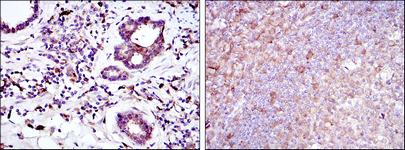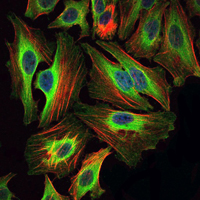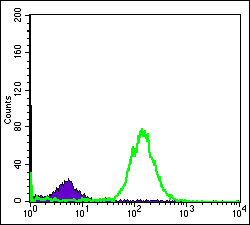BID Monoclonal Antibody
- Catalog No.:YM0062
- Applications:WB;IHC;IF;FCM;ELISA
- Reactivity:Human
- Target:
- BID
- Fields:
- >>Platinum drug resistance;>>Sphingolipid signaling pathway;>>p53 signaling pathway;>>Apoptosis;>>Apoptosis - multiple species;>>Necroptosis;>>Natural killer cell mediated cytotoxicity;>>Non-alcoholic fatty liver disease;>>Alzheimer disease;>>Amyotrophic lateral sclerosis;>>Pathways of neurodegeneration - multiple diseases;>>Tuberculosis;>>Hepatitis C;>>Hepatitis B;>>Measles;>>Human cytomegalovirus infection;>>Influenza A;>>Kaposi sarcoma-associated herpesvirus infection;>>Herpes simplex virus 1 infection;>>Epstein-Barr virus infection;>>Human immunodeficiency virus 1 infection;>>Pathways in cancer;>>Viral myocarditis;>>Lipid and atherosclerosis
- Gene Name:
- BID
- Protein Name:
- BH3-interacting domain death agonist
- Human Gene Id:
- 637
- Human Swiss Prot No:
- P55957
- Mouse Swiss Prot No:
- P70444
- Immunogen:
- Purified recombinant fragment of human BID expressed in E. Coli.
- Specificity:
- BID Monoclonal Antibody detects endogenous levels of BID protein.
- Formulation:
- Liquid in PBS containing 50% glycerol, 0.5% BSA and 0.02% sodium azide.
- Source:
- Monoclonal, Mouse
- Dilution:
- WB 1:500 - 1:2000. IHC 1:200 - 1:1000. IF 1:200 - 1:1000. Flow cytometry: 1:200 - 1:400. ELISA: 1:10000. Not yet tested in other applications.
- Purification:
- Affinity purification
- Storage Stability:
- -15°C to -25°C/1 year(Do not lower than -25°C)
- Other Name:
- BID;BH3-interacting domain death agonist;p22 BID;BID
- Molecular Weight(Da):
- 22kD
- References:
- 1. Photochem Photobiol. 2008 Jan-Feb;84(1):250-7.
2. Cell Signal. 2007 Dec;19(12):2468-78.
- Background:
- This gene encodes a death agonist that heterodimerizes with either agonist BAX or antagonist BCL2. The encoded protein is a member of the BCL-2 family of cell death regulators. It is a mediator of mitochondrial damage induced by caspase-8 (CASP8); CASP8 cleaves this encoded protein, and the COOH-terminal part translocates to mitochondria where it triggers cytochrome c release. Multiple alternatively spliced transcript variants have been found, but the full-length nature of some variants has not been defined. [provided by RefSeq, Jul 2008],
- Function:
- domain:Intact BH3 motif is required by BIK, BID, BAK, BAD and BAX for their pro-apoptotic activity and for their interaction with anti-apoptotic members of the Bcl-2 family.,function:The major proteolytic product p15 BID allows the release of cytochrome c (By similarity). Isoform 1, isoform 2 and isoform 4 induce ICE-like proteases and apoptosis. Isoform 3 does not induce apoptosis. Counters the protective effect of Bcl-2.,PTM:Phosphorylated upon DNA damage, probably by ATM or ATR.,PTM:TNF-alpha induces a caspase-mediated cleavage of p22 BID into a major p15 and minor p13 and p11 products.,subcellular location:A significant proportion of isoform 2 localizes to mitochondria, it may be cleaved constitutively.,subcellular location:Associated with the mitochondrial membrane.,subcellular location:Translocates to mitochondria as an integral membrane protein.,subcellular location:When uncleaved
- Subcellular Location:
- Cytoplasm . Mitochondrion membrane . Mitochondrion outer membrane . When uncleaved, it is predominantly cytoplasmic. .; [BH3-interacting domain death agonist p15]: Mitochondrion membrane . Translocates to mitochondria as an integral membrane protein. .; [BH3-interacting domain death agonist p13]: Mitochondrion membrane . Associated with the mitochondrial membrane. .; [Isoform 1]: Cytoplasm .; [Isoform 3]: Cytoplasm .; [Isoform 2]: Mitochondrion membrane . A significant proportion of isoform 2 localizes to mitochondria, it may be cleaved constitutively. .
- Expression:
- [Isoform 2]: Expressed in spleen, pancreas and placenta (at protein level). ; [Isoform 3]: Expressed in lung, pancreas and spleen (at protein level). ; [Isoform 4]: Expressed in lung and pancreas (at protein level).
Upregulation of microRNA‑492 induced by epigenetic drug treatment inhibits the malignant phenotype of clear cell renal cell carcinoma in vitro. Molecular Medicine Reports Mol Med Rep. 2015 Jul;12(1):1413-1420 WB Human 1:500 786-O cell, ACHN cell
- June 19-2018
- WESTERN IMMUNOBLOTTING PROTOCOL
- June 19-2018
- IMMUNOHISTOCHEMISTRY-PARAFFIN PROTOCOL
- June 19-2018
- IMMUNOFLUORESCENCE PROTOCOL
- September 08-2020
- FLOW-CYTOMEYRT-PROTOCOL
- May 20-2022
- Cell-Based ELISA│解您多样本WB检测之困扰
- July 13-2018
- CELL-BASED-ELISA-PROTOCOL-FOR-ACETYL-PROTEIN
- July 13-2018
- CELL-BASED-ELISA-PROTOCOL-FOR-PHOSPHO-PROTEIN
- July 13-2018
- Antibody-FAQs
- Products Images

- Western Blot analysis using BID Monoclonal Antibody against HeLa (1), A431 (2), Jurkat (3), A549 (4), HepG2 (5), and HEK293 (6) cell lysate.

- Immunohistochemistry analysis of paraffin-embedded prostate tissues (left) and tonsil tissues (right) with DAB staining using BID Monoclonal Antibody.

- Immunofluorescence analysis of Hela cells using BID Monoclonal Antibody (green). Blue: DRAQ5 fluorescent DNA dye. Red: Actin filaments have been labeled with Alexa Fluor-555 phalloidin.

- Flow cytometric analysis of Hela cells using BID Monoclonal Antibody (green) and negative control (purple)




